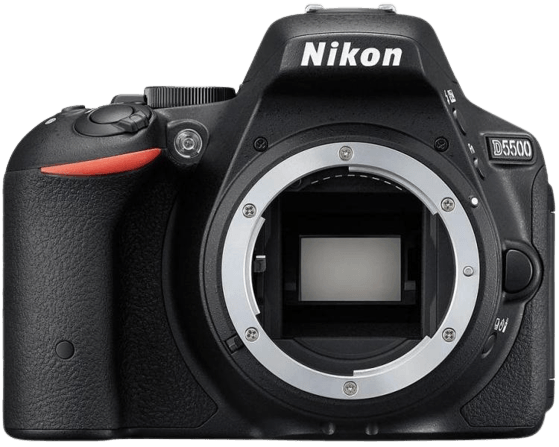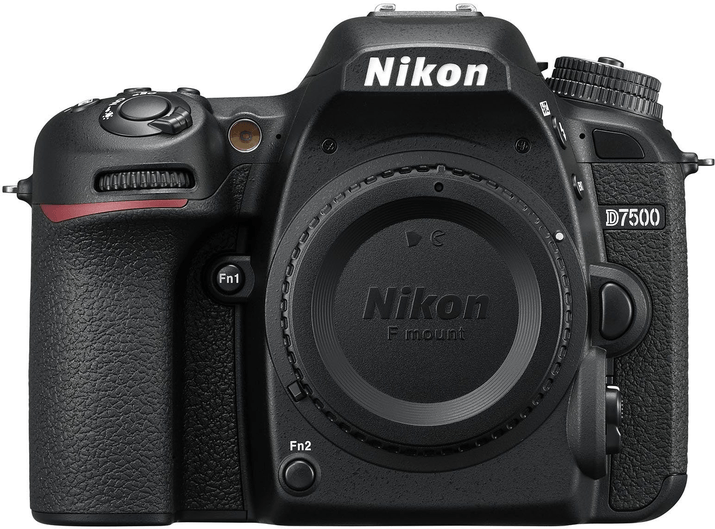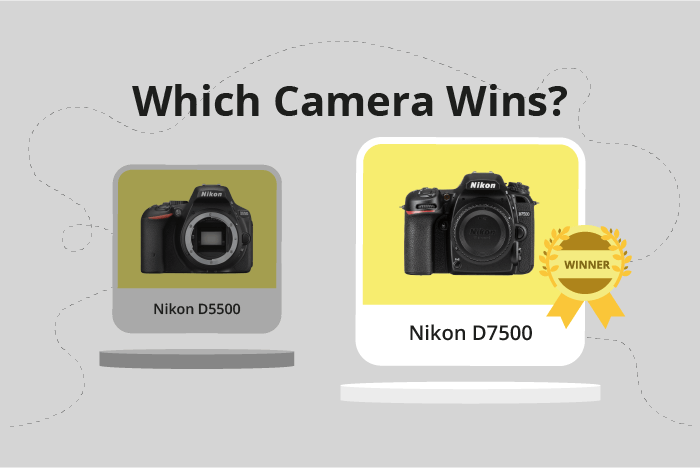Nikon D5500 vs D7500 Comparison
Nikon D5500

Nikon D7500

The Nikon D7500 emerges as the winner with a score of 70/100, outperforming the Nikon D5500, which scored 61/100. Both cameras are DSLRs, released in 2015 and 2017 respectively, with the D5500 initially priced at $900 and the D7500 at $1250. They share similarities in size and weight, with the D5500 measuring 124 x 97 x 70mm and weighing 420g, while the D7500 is slightly larger at 136 x 104 x 73mm and heavier at 720g.
The D7500 surpasses the D5500 with its higher score, reflecting its superior performance and features, justifying the higher launch price. However, the D5500 holds its ground as a more compact and lightweight option, making it suitable for those prioritizing portability.
Taking all factors into account, the Nikon D7500 stands out as the better camera, while the Nikon D5500 remains a viable choice for those focused on size and weight.
Nikon D5500 vs D7500 Overview and Optics
The Nikon D7500 emerges as the winner in the optics comparison with a score of 68/100, while the Nikon D5500 trails behind with a score of 65/100. Both cameras share several common specifications such as the CMOS sensor type, APS-C sensor size, Nikon F DX lens mount, and lack of image stabilization.
The D7500 excels in certain aspects, such as its shooting speed and processor. With an impressive shooting speed of 8 frames per second (fps), the D7500 surpasses the D5500’s 5 fps, providing better performance for capturing fast-moving subjects. Additionally, the D7500 boasts an advanced Expeed 5 processor, while the D5500 utilizes the older Expeed 4 processor. The improved processor in the D7500 contributes to its higher DXOMARK sensor score of 86 compared to the D5500’s score of 84, indicating an overall better image quality.
On the other hand, the D5500 has a higher megapixel count at 24.2 compared to the D7500’s 20.9 megapixels. This higher resolution allows the D5500 to capture more intricate details in images and provides larger print sizes. However, in practical use, the difference in megapixel count may not be significant enough to impact the overall image quality.
Taking these factors into account, the Nikon D7500 proves to be the superior camera in terms of optics, with its faster shooting speed, advanced processor, and better sensor score. Nonetheless, the Nikon D5500 still holds its ground with a higher megapixel count, offering a viable option for those seeking higher resolution images.
Nikon D5500 vs D7500 Video Performance
The Nikon D5500 and Nikon D7500 have the same video score of 70/100. Both cameras share some common specifications, such as having built-in time-lapse functionality. However, there are differences between their video capabilities, which will be discussed in the following paragraphs.
The Nikon D7500 surpasses the D5500 in terms of video resolution, offering 4K (3840 x 2160) compared to the D5500’s Full HD (1920 x 1080). This higher resolution means the D7500 captures more detail and produces sharper video quality. Therefore, the D7500 is the better choice for those who prioritize video resolution.
On the other hand, the Nikon D5500 has a higher maximum video frame rate of 60fps, while the D7500’s maximum is 30fps. This means the D5500 can capture smoother motion in videos, which is especially beneficial for recording fast-moving subjects or creating slow-motion effects. In this aspect, the D5500 outperforms the D7500.
Taking these factors into consideration, the choice between the Nikon D5500 and D7500 will depend on individual preferences and video requirements. The D7500’s 4K resolution makes it the superior choice for users who value high-detail video quality. Meanwhile, the D5500’s higher frame rate of 60fps is advantageous for those who need smoother motion capture in their videos. Both cameras offer time-lapse functionality, making them suitable for creative video projects. Therefore, potential buyers should weigh the importance of video resolution and frame rate to determine which camera best meets their needs.
Nikon D5500 vs D7500 Features and Benefits
The Nikon D7500 emerges as the winner in the comparison of features, with a score of 83/100, while the Nikon D5500 scores 59/100. Both cameras share several specifications, including a 3.2-inch screen size, touchscreen capabilities, flip screen, GPS absence, and Wi-Fi connectivity.
The D7500 surpasses the D5500 in its feature set, most notably with the addition of Bluetooth connectivity. This feature allows for seamless and easy transfer of images and remote control of the camera, making it more versatile and convenient for users.
However, the D5500 has a slight advantage in screen resolution, with 1,037,000 dots, compared to the D7500’s 922,000 dots. This means the D5500 offers a slightly clearer and sharper display for image preview and review, which some users may prefer.
Taking all these points into consideration, the Nikon D7500 stands out as the superior camera in terms of features. Its Bluetooth connectivity adds value and enhances the user experience. On the other hand, the Nikon D5500 may be more appealing to users who prioritize screen resolution. Ultimately, the choice between these two cameras depends on the individual’s preferences and requirements, but the Nikon D7500’s higher feature score reflects its overall advantage in this comparison.
Nikon D5500 vs D7500 Storage and Battery
The Nikon D7500 outperforms the Nikon D5500 in storage and battery, scoring 43/100 compared to the D5500’s 35/100. Both cameras share similarities in storage, with one memory card slot each and compatibility with SD, SDHC, and SDXC cards. Neither camera offers USB charging.
The D7500’s advantage lies in its longer battery life, providing 950 shots per charge with its EN-EL15a battery. This surpasses the D5500’s 820 shots using the EN-EL14 battery. The D5500 does not have any notable advantages in storage and battery over the D7500.
Considering these points, the Nikon D7500 proves to be better in terms of storage and battery life, making it a more reliable option for extended shooting sessions. The D5500, although falling short, still offers decent battery life and storage capabilities for casual photography needs.
Nikon D5500 vs D7500 – Our Verdict
Are you still undecided about which camera is right for you? Have a look at these popular comparisons that feature the Nikon D5500 or the Nikon D7500:

